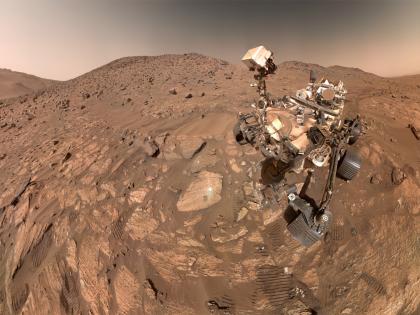Scientists just found strongest signs of life on Mars yet: Study
By ANI | Updated: October 1, 2025 23:15 IST2025-10-01T23:11:23+5:302025-10-01T23:15:14+5:30
Washington DC [US], October 1 : A new study suggests a habitable past and signs of ancient microbial processes ...

Scientists just found strongest signs of life on Mars yet: Study
Washington DC [US], October 1 : A new study suggests a habitable past and signs of ancient microbial processes on Mars and Imperial scientists provided crucial context.
Led by NASA and featuring key analysis from Imperial College London, the work has uncovered a range of minerals and organic matter in Martian rocks that point to an ancient history of habitable conditions and potential biological processes on the Red Planet.
An international team, including researchers from the Department of Earth Science and Engineering (ESE) at Imperial, propose that these geological features within the so-called Bright Angel formation in Mars's Jezero Crater are closely connected to organic carbon, and could be a compelling potential biosignature of past life.
Professor Sanjeev Gupta, Professor of Earth Science in ESE, and Academic Co-director of Imperial Global India, said: "This is a very exciting discovery of a potential biosignature, but it does not mean we have discovered life on Mars. We now need to analyse this rock sample on Earth to truly confirm if biological processes were involved or not."
A core component of NASA's Mars 2020 mission, the Perseverance Rover has been exploring the 45-kilometre-wide Jezero Crater since 2021, a site chosen because it once held a huge lake and a river delta - environments that are considered prime targets in the search for signs of past life.
Its key goal is to collect and store the first set of selected rock and soil samples that will be brought back to Earth for detailed analysis.
The new study, published in Nature, focuses on a distinctly light-toned outcrop in the crater, dubbed 'Bright Angel', located within an ancient river valley which provided water to the Jezero lake.
While driving through the valley, called Neretva Vallis, Perseverance came across a thick succession of fine-grained mudstones and muddy conglomerates.
Here, it conducted a detailed analysis of these rocks, using instruments such as the Planetary Instrument for X-ray Lithochemistry (PIXL) and Scanning Habitable Environments with Raman & Luminescence for Organics & Chemicals (SHERLOC).
By mapping the types and distributions of different sedimentary rocks at Bright Angel, ESE researchers (including Professor Gupta and Dr Robert Barnes, a Research Associate in ESE, who were both funded by the UK Space Agency), were able to reconstruct the environment in which these mudstones were deposited.
Their analysis revealed a range of sedimentary structures and textures indicative of lake margin and lake bed environments, including a composition rich in minerals like silica and clays - the opposite to a river scenario, where fast-moving water would carry these tiny particles away.
This pointed to a surprising conclusion: they had found lake deposits at the bottom of a river valley. Lake deposits at the bottom of a river valley.
Co-author Alex Jones, a PhD researcher in ESE and collaborating scientist with the NASA Perseverance team, who has conducted a detailed analysis of the ancient lake environment, said, "This is unusual but very intriguing, as we wouldn't expect to find such deposits in Neretva Vallis. What our sedimentological and stratigraphic work has done is indicate a past, low-energy lake environment - and that is precisely the kind of habitable environment we have been looking for on the mission."
The finding may suggest a period in the history of Jezero Crater where the valley itself was flooded, giving rise to this potentially habitable lake.
Disclaimer: This post has been auto-published from an agency feed without any modifications to the text and has not been reviewed by an editor
Open in app